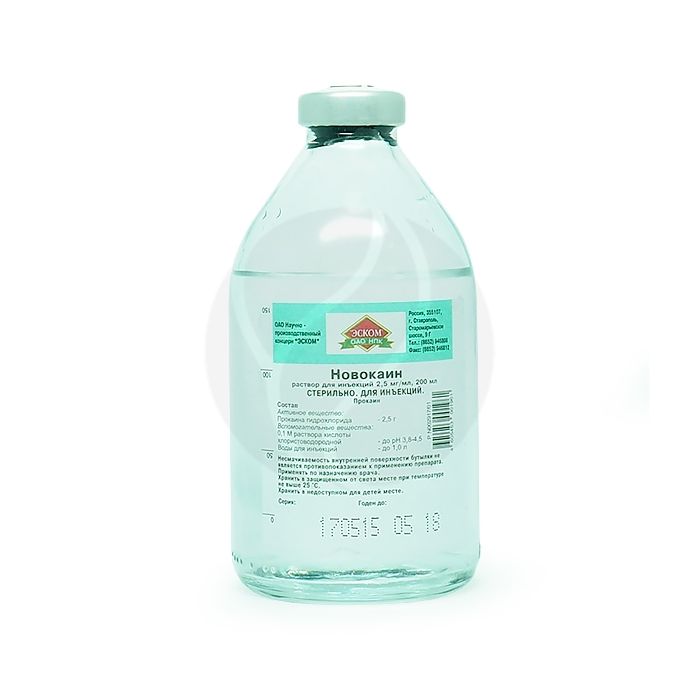Novocaine solution 0.25%, 200ml
Expiration Date: 05/2027
Russian Pharmacy name:
Новокаин раствор 0,25%, 200мл
Infiltration, conduction, epidural and spinal anesthesia, intraosseous anesthesia, mucosal anesthesia (in ENT practice); vagosympathetic and perirenal blockade. Circular and paravertebral blockade for eczema, neurodermatitis, ischalgia.
I / O: to potentiate the action of basic drugs for anesthesia; for relief of pain syndrome of various origins.
V / m: to dissolve penicillin in order to lengthen its duration; as an aid for certain diseases that are more common in old age, incl. endarteritis, atherosclerosis, arterial hypertension, spasms of the coronary vessels and cerebral vessels, diseases of the joints of rheumatic and infectious genesis.
With local anesthesia, the dose of the drug depends on the concentration, the nature of the surgical intervention, the route of administration, the condition and age of the patient.
In case of perirenal blockade, 50-70 ml of 0.5% (5 mg / ml) Novocaine solution is injected into the perirenal tissue for adults.
For infiltration anesthesia, the following higher doses are established (for adults): the first single dose at the beginning of the operation is 0.75 g (i.e. 150 ml of 0.5% novocaine solution).
Further, during each hour of the operation, no more than 2 g (i.e. 400 ml of 0.5% novocaine solution).
Solution for infusion 0.25%
1 ml
procaine 2.5 mg
Hypersensitivity to procaine.
pharmachologic effect
Local anesthetic with moderate anesthetic activity and wide therapeutic range. Being a weak base, it blocks sodium channels, displaces calcium from receptors located on the inner surface of the membrane and, thus, prevents the generation of impulses in the endings of sensory nerves and the conduction of impulses along nerve fibers. Changes the action potential in the membranes of nerve cells without a pronounced effect on the resting potential. Suppresses conduction of not only painful, but also impulses of a different modality. When it enters the systemic circulation, it reduces the excitability of peripheral cholinergic systems, reduces the formation and release of acetylcholine from the preganglionic endings (has a weak ganglion blocking effect), eliminates smooth muscle spasm,reduces the excitability of the myocardium and motor areas of the cerebral cortex. Compared to lidocaine and bupivacaine, procaine has a less pronounced anesthetic effect and, therefore, has a relatively low toxicity and a greater therapeutic range.
Pharmacokinetics
Poorly absorbed through mucous membranes. When administered parenterally, it is well absorbed, rapidly hydrolyzed by plasma and tissue esterases with the formation of two main pharmacologically active metabolites: diethylaminoethanol (has a moderate vasodilating effect) and PABA. T1 / 2 - 0.7 min. It is excreted mainly by the kidneys in the form of metabolites - 80%.
Side effect
Possibly: arterial hypotension, collapse, dizziness, weakness, urticaria, allergic reactions, anaphylactic shock.
special instructions
It should be borne in mind that when conducting local anesthesia when using the same total dose, the toxicity of procaine is the higher, the more concentrated the solution used is. Procaine slowly penetrates through intact mucous membranes, therefore it is not very effective for surface anesthesia. As an adjuvant, procaine is used intravenously and orally for arterial hypertension, late toxicosis of pregnant women with hypertensive syndrome, spasms of blood vessels, phantom pain, gastric ulcer and duodenal ulcer, NUC, itching, neurodermatitis, eczema, keratitis, iridocyclitis.
Drug interactions
When administered intravenously, it enhances the depressing effect on the central nervous system of agents for general anesthesia, hypnotics, sedatives, narcotic analgesics and tranquilizers. The procaine metabolite PABA is a competitive antagonist of sulfonamides and can weaken their antimicrobial action.

